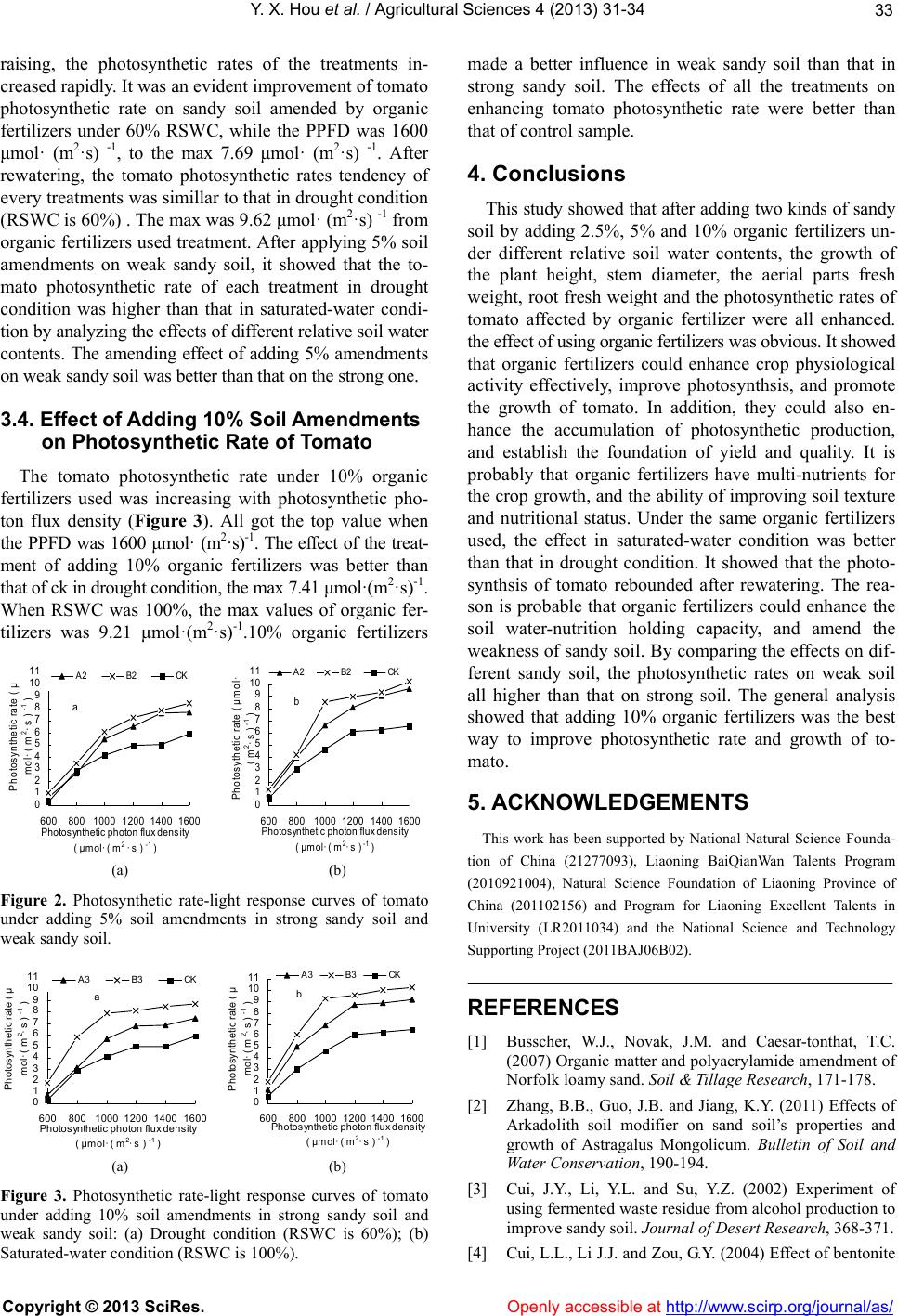
Y. X. Hou et al. / Agricultural Sciences 4 (2013) 31-34 33
raising, the photosynthetic rates of the treatments in-
creased rapidly. It was an evident improvement of tomato
photosynthetic rate on sandy soil amended by organic
fertilizers under 60% RSWC, while the PPFD was 1600
μmol· (m2·s) -1 , to the max 7.69 μmol· (m2·s) -1. After
rewatering, the tomato photosynthetic rates tendency of
every treatments was simillar to that in drought condition
(RSWC is 60%) . The max was 9.62 μmol· (m2·s) -1 from
organic fertilizers used treatment. After applying 5% soil
amendments on weak sandy soil, it showed that the to-
mato photosynthetic rate of each treatment in drought
condition was higher than that in saturated-water condi-
tion by analyzing the effects of different relative soil water
contents. The amending effect of adding 5% amendments
on weak sandy soil was better than that on the strong one.
3.4. Effect of Adding 10% Soil Amendments
on Photosynthetic Rate of Tomato
The tomato photosynthetic rate under 10% organic
fertilizers used was increasing with photosynthetic pho-
ton flux density (Figure 3). All got the top value when
the PPFD was 1600 μmol· (m2·s)-1. The effect of the treat-
ment of adding 10% organic fertilizers was better than
that of ck in drought condition, the max 7.41 μmol·( m 2·s)-1.
When RSWC was 100%, the max values of organic fer-
tilizers was 9.21 μmol· (m2·s)-1.10% organic fertilizers
a
0
1
2
3
4
5
6
7
8
9
10
11
60080010001200 1400 1600
Photosynthetic photon flux density
( μmol· ( m
2
· s )
-1
)
Photosynthetic rate ( μ
mol· ( m
2
· s )
-1
)
A2 B2 CK
b
0
1
2
3
4
5
6
7
8
9
10
11
6008001000 1200 1400 1600
Photosynthetic photon flux density
( μmol· ( m
2
· s )
-1
)
Photosythetic rate ( μmol·
( m
2
· s )
-1
)
A2 B2 CK
(a) (b)
Figure 2. Photosynthetic rate-light response curves of tomato
under adding 5% soil amendments in strong sandy soil and
weak sandy soil.
a
0
1
2
3
4
5
6
7
8
9
10
11
60080010001200 14001600
Photosynthetic photon flux density
( μmol· ( m
2
· s )
-1
)
Photosynthetic rate ( μ
mol· ( m
2
· s )
-1
)
A3 B3 CK
b
0
1
2
3
4
5
6
7
8
9
10
11
6008001000 1200 1400 1600
Photosynthetic photon flux density
( μmol· ( m
2
· s )
-1
)
Photosynthetic rate ( μ
mol· ( m
2
· s )
-1
)
A3 B3 CK
(a) (b)
Figure 3. Photosynthetic rate-light response curves of tomato
under adding 10% soil amendments in strong sandy soil and
weak sandy soil: (a) Drought condition (RSWC is 60%); (b)
Saturated-water condition (RSWC is 100%).
made a better influence in weak sandy soil than that in
strong sandy soil. The effects of all the treatments on
enhancing tomato photosynthetic rate were better than
that of control sample.
4. Conclusions
This study showed that after adding two kinds of sandy
soil by adding 2.5%, 5% and 10% organic fertilizers un-
der different relative soil water contents, the growth of
the plant height, stem diameter, the aerial parts fresh
weight, root fresh weight and the photosynthetic rates of
tomato affected by organic fertilizer were all enhanced.
the effect of using organic fertilizers was obvious. It showed
that organic fertilizers could enhance crop physiological
activity effectively, improve photosynthsis, and promote
the growth of tomato. In addition, they could also en-
hance the accumulation of photosynthetic production,
and establish the foundation of yield and quality. It is
probably that organic fertilizers have multi-nutrients for
the crop growth, and the ability of improving soil texture
and nutritional status. Under the same organic fertilizers
used, the effect in saturated-water condition was better
than that in drought condition. It showed that the photo-
synthsis of tomato rebounded after rewatering. The rea-
son is probable that organic fertilizers could enhance the
soil water-nutrition holding capacity, and amend the
weakness of sandy soil. By comparing the effects on dif-
ferent sandy soil, the photosynthetic rates on weak soil
all higher than that on strong soil. The general analysis
showed that adding 10% organic fertilizers was the best
way to improve photosynthetic rate and growth of to-
mato.
5. ACKNOWLEDGEMENTS
This work has been supported by National Natural Science Founda-
tion of China (21277093), Liaoning BaiQianWan Talents Program
(2010921004), Natural Science Foundation of Liaoning Province of
China (201102156) and Program for Liaoning Excellent Talents in
University (LR2011034) and the National Science and Technology
Supporting Project (2011BAJ06B02).
REFERENCES
[1] Busscher, W.J., Novak, J.M. and Caesar-tonthat, T.C.
(2007) Organic matter and polyacrylamide amendment of
Norfolk loamy sand. Soil & Tillage Research, 171-178.
[2] Zhang, B.B., Guo, J.B. and Jiang, K.Y. (2011) Effects of
Arkadolith soil modifier on sand soil’s properties and
growth of Astragalus Mongolicum. Bulletin of Soil and
Water Conservation, 190-194.
[3] Cui, J.Y., Li, Y.L. and Su, Y.Z. (2002) Experiment of
using fermented waste residue from alcohol production to
improve sandy soil. Journal of Desert Research, 368-371.
[4] Cui, L.L., Li J.J. and Zou, G.Y. (2004) Effect of bentonite
Copyright © 2013 SciRes. Openly accessible at http://www.scirp.org/journal/as/